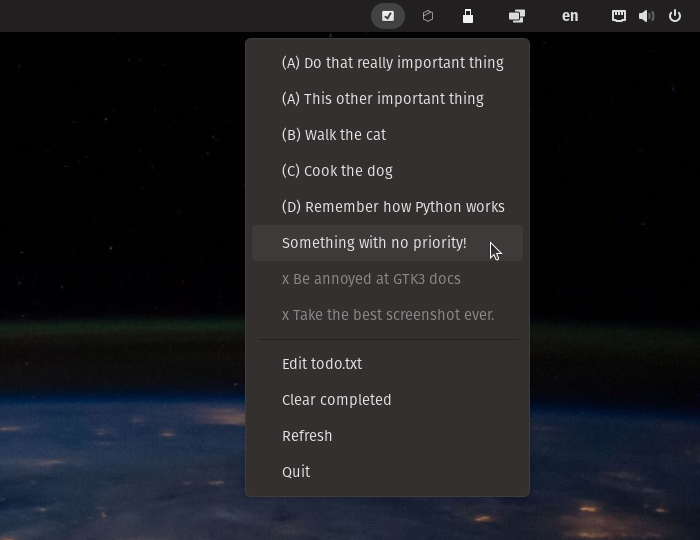An Ubuntu app indicator for todo.txt-style todo lists
Project description
todo-indicator
An Ubuntu app indicator for todo.txt-style todo lists.
Installation
Install todo-indicator with pip:
pip install todo-indicator
However, todo-indicator has some system dependencies which pip can't
satisfy. The following should ensure you have everything you need:
sudo apt install python3-pyinotify python3-gi gir1.2-appindicator3-0.1
(The above is verified working on Ubuntu 20.04 and 22.04. I can't speak for other versions or distros, but it will likely be something similar.)
You can also simply clone the repo and run the provided todo-indicator
binary directly, without installing it. You'll still need to install the
required dependencies as described above, however.
Requirements
- Python 3
- The above-mentioned system dependencies
- An app-indicator-aware system tray of some kind (you might need a plugin if you're running a non-Ubuntu distro)
Usage
Just run todo-indicator, passing the name of your todo.txt file as an
argument, e.g.:
todo-indicator ~/todo.txt
Click the indicator icon to see your list. If you finish one of your tasks, give yourself a pat on the back and click it! It'll be marked "done."
Editing your list
todo-indicator's goal is to show you your list and let you check items off.
Anything more complex than that, you'll want to use your trusty text editor.
Click "Edit todo.txt" and your todo list will open in your text editor of
choice. (Or your OS's text editor of choice, at least -- it uses xdg-open.)
Once you've made your changes and saved the file, you should see your updates
automatically reflected in the todo-indicator UI. (Thanks, inotify!)
If for some reason the indicator doesn't update, click "Refresh".
Command-line options
Use -e/--editor to specify a text editor other than your default:
todo-indicator -e gvim ~/todo.txt
todo-indicator assumes a dark-colored panel by default. If you use a
light-colored panel, you can pass the -i/--invert option to invert the
icon color:
todo-indicator -i ~/todo.txt
Contributing
Check the Makefile for some common operations like code formatting, linting,
and running unit tests.
If you install/run todo-indicator inside a virtual env (usually recommended
for development), you'll need to install the dependencies from the
requirements.txt file:
pip install -r requirements.txt
This includes PyGObject, which itself needs some extra development
dependencies to be installed on your system. See the PyGObject
docs
for more info.
Alternatively, you can skip this step, install the "normal" system-level
dependencies from the Installation section, and create your
virtual env with the --system-site-packages option:
python -m venv --system-site-packages .venv
This will allow your local, virtual env version of todo-indicator to import
your system-level python libraries (in particular the gi package).
Project details
Release history Release notifications | RSS feed
Download files
Download the file for your platform. If you're not sure which to choose, learn more about installing packages.
Source Distribution
Built Distribution
Hashes for todo_indicator-0.7.0-py3-none-any.whl
| Algorithm | Hash digest | |
|---|---|---|
| SHA256 | f0704efaff1e994ff3723aa5b380515b7429316fc12ab28cbaf5a36fc134e4ab |
|
| MD5 | 8294a4e46fd4787403d8ee3ed05e4cdb |
|
| BLAKE2b-256 | bb706121532f365703b02b2c9e4814176ce823225264d7c5663db6fef6fb59a6 |











